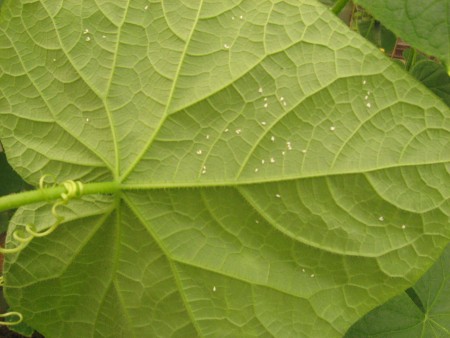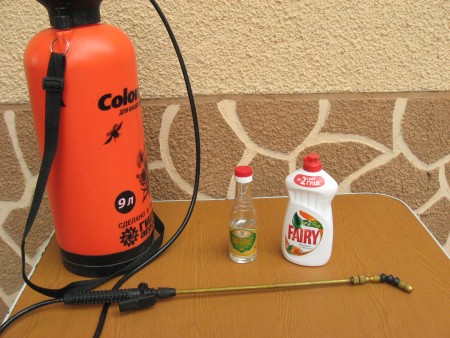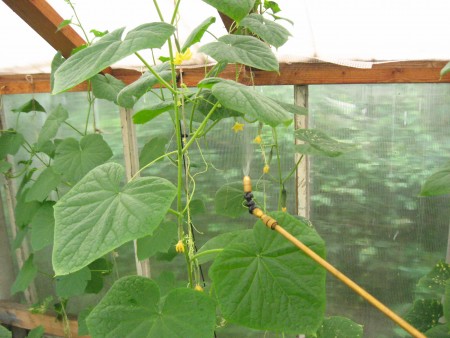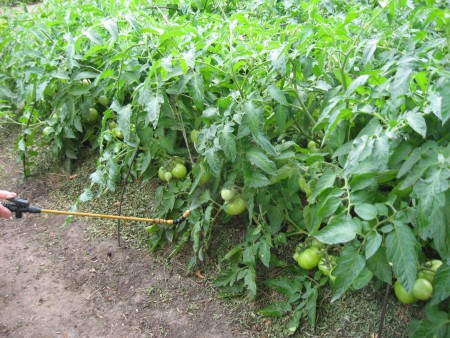Aphids are one of the most common cucumber pests. Countless hordes of insects suck the juice from the leaves, resulting in the plant turn yellow and dry out.
What does aphid look like? Here is a photo of aphids: small white dots on a cucumber leaf, these are pests.

This is what a whitefly or white aphid looks like
For all summer residents who have been tormented by aphids in greenhouses and gardens, there is good news! You can get rid of aphids on cucumbers and tomatoes relatively easily and quickly. In addition, we will fight aphids with folk remedies, which means that our plants can be sprayed at any time, even while the fruits are ripening.
There are many ways to combat these parasites described on the Internet. Many of them are quite effective, but some pose a danger to the plants themselves. Trying to kill aphids, I once burned tomatoes with red pepper infusion, although I did everything strictly according to the recipe.
But most importantly, all these folk methods of fighting aphids have one common drawback - they are difficult to implement. In all the proposed options, the grass, tops, and onion peels must first be collected, chopped, boiled, left for several days, and strained. Moreover, you must strain very carefully, otherwise the sprayer will clog all the time.
And all this must be done several times, because not a single folk remedy will get rid of aphids in one treatment.
Not every gardener has the patience for even one such procedure, and if you imagine that there are 3 or 4 more such treatments ahead, then anyone will give up.
The simplest folk remedy for fighting aphids
Fortunately, I came across one very simple recipe for a folk remedy for killing aphids. I would like to share this recipe with pleasure with the readers of Dacha Plot. This solution is extremely easy and quick to prepare, literally in one minute.
To prepare it, you will need to buy a bottle of 70% food vinegar and a bottle of Ferry (dishwashing liquid).Add vinegar to the water at the rate of 1 teaspoon of vinegar per 1 liter of water. It turns out that a bucket of water will require 10 teaspoons. I add ferry by eye, about 3 - 4 tablespoons per bucket. You can, of course, make laundry soap, but with Ferry it’s easier - just pour it into water and that’s it, and the result is the same.
We need to talk separately about the sprayer. A mini sprayer like the “Rosinka” is not suitable for fighting aphids. These pests are located exclusively on the underside of the leaves and in order for the solution to reach them, it must be sprayed from bottom to top. Therefore, the spray nozzle on the sprayer should be flexible and easily directed up and down, such as in the photo.
Of course, it is easier to spray cucumbers that grow on a trellis; with cucumbers creeping along the ground it will be somewhat more difficult, but also quite doable. You will have to spray every leaf, because under each leaf there is a whole colony of these nasty bugs.
If there are a lot of aphids on tomatoes or cucumbers, then you will have to carry out several treatments in a row after 2 - 3 days. Subsequently, you can spray the plants as needed. For us, such a need occurs in about 3 weeks.
I have been using this method of fighting aphids for the second year now and therefore I confidently recommend it to everyone who cannot yet cope with these pests.
I myself have tried many methods, but only with the help of vinegar was it possible to get rid of aphids in greenhouses on both tomatoes and cucumbers. I haven’t tried to process trees this way, but I plan to.
If anyone has their own productive folk methods of fighting aphids, write about them in the comments. All our readers will be grateful to you.
You might be interested in:




 (12 ratings, average: 4,50 out of 5)
(12 ratings, average: 4,50 out of 5) CUCUMBERS NEVER GET SICK, I'VE BEEN USING ONLY THIS FOR 40 YEARS! I SHARE A SECRET WITH YOU, CUCUMBERS ARE LIKE THE PICTURE!
CUCUMBERS NEVER GET SICK, I'VE BEEN USING ONLY THIS FOR 40 YEARS! I SHARE A SECRET WITH YOU, CUCUMBERS ARE LIKE THE PICTURE! You can dig a bucket of potatoes from each bush. Do you think these are fairy tales? Watch the video
You can dig a bucket of potatoes from each bush. Do you think these are fairy tales? Watch the video
 How our fellow gardeners work in Korea. There is a lot to learn and just fun to watch.
How our fellow gardeners work in Korea. There is a lot to learn and just fun to watch. Eye trainer. The author claims that with daily viewing, vision is restored. They don't charge money for views.
Eye trainer. The author claims that with daily viewing, vision is restored. They don't charge money for views. A 3-ingredient cake recipe in 30 minutes is better than Napoleon. Simple and very tasty.
A 3-ingredient cake recipe in 30 minutes is better than Napoleon. Simple and very tasty. Therapeutic exercises for cervical osteochondrosis. A complete set of exercises.
Therapeutic exercises for cervical osteochondrosis. A complete set of exercises. Which indoor plants match your zodiac sign?
Which indoor plants match your zodiac sign? What about them? Excursion to German dachas.
What about them? Excursion to German dachas.
The aphids ate both cucumbers and tomatoes, but it all started with Chinese cabbage! I’ll try your recipe, if it helps, God grant you great health and strength in this difficult work!
Thanks for the information about vinegar!!! I tried it on cucumbers and apple trees, it really helped. At first I forgot to add detergent, and during the test treatment the guard ants grabbed the aphid larvae and ran away holding them in their jaws. And after repeated treatment with detergent, the next day there are no aphids or ants. A very useful method considering that cucumbers grow very quickly and need to be collected every day.
And if not, 70 percent. Acids? How much 9 percent vinegar per bucket?
Lyuba, 9% vinegar is about 8 times weaker than 70%, which means 1 liter of water will require 8 teaspoons of vinegar, and 80 spoons per bucket.
Isn't there too much vinegar? Will it harm the plants?
Svetlana, I have been spraying cucumbers this way for several years now and have never had any burns on the leaves. You just can’t increase the concentration of vinegar, otherwise you can actually harm the plants.
How will this treatment be reflected on the fruits and is it possible to eat these fruits after treatment???
Mikhail, well, this is table vinegar, it’s used to make pickles for the winter, and kebabs are soaked in it.
We sprayed black currants against aphids with the famously poisonous Coca-Cola drink with the addition of green soap (also read somewhere) - it helped. Now the aphids have eaten cucumbers, bell peppers, etc., we sprayed them with the same thing, but I’m afraid that the aphids have not completely died, there are too many of them. After a break of several days, we will try your method, but maybe instead of regular soap, use potassium soap again, i.e. “green soap”, what do you think?
Irina, any soap will do for this purpose.
You can also use a dewdrop (mini sprayer) if you pull out the tube going to the bottom from the inside and turn the sprayer over! I did this myself today.
I treated the leaves with vinegar for aphids; they grow on the balcony. The leaves were burned! The aphids haven't left! What to do?? Lost my cucumbers? Or will they still survive?
Anna, what concentration of the solution did you use, one teaspoon per 1 liter of water? We have been processing cucumbers and tomatoes this way in the greenhouse for 4 years now and have never had any burns on the leaves. Maybe you sprayed it during the day, in the sun, or gave it vinegar.
The method is really good, we’ve been using it for 2 years now. But you need to spray regularly, preferably once every 10 days. Processing alone is of little use.
Instead of vinegar, you can use ammonia, which also helps.
Can you tell me more about the use of ammonia?
Nothing tricky, add 50 ml of ammonia to a bucket of water and spray for health. Well, you also need some kind of adhesive, for example soap.